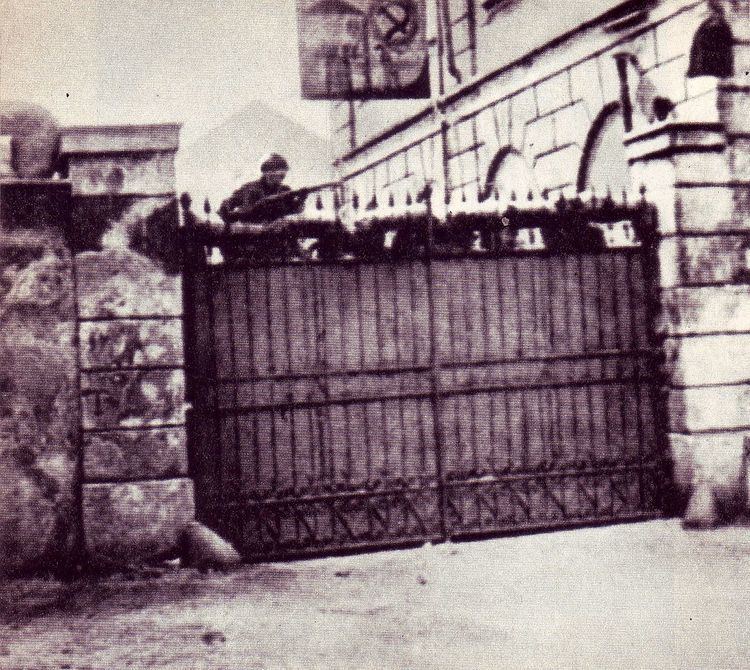Monarch – Victor Emmanuel III (1900–1946)
Prime Minister –
- Francesco Saverio Nitti (1919–1920)
- Giovanni Giolitti (1920–1921)
Population – 35,960,000
In 1920, militant strike activity by industrial workers reaches its peak in Italy; 1919 and 1920 were known as the "Red Years". Benito Mussolini and the Fascists take advantage of the situation by allying with industrial businesses and attacking workers and peasants in the name of preserving order and internal peace in Italy.
February 12–24 – Conference of London: Leaders of the United Kingdom, France and Italy meet to discuss the partitioning of the Ottoman Empire. The allied powers reach agreements that would form the basis of their arguments at the San Remo conference.
April – Turin metal-workers, in particular at the Fiat plants, go on strike demanding recognition for their 'factory councils'. The 'factory councils' more and more saw themselves as the models for a new democratically controlled economy running industrial plants, instead of as a bargaining tool with employers.
April 19–26 – San Remo conference: Representatives of Italy, France, the United Kingdom and Japan meet to determine the League of Nations mandates for administration of territories following partitioning of the Ottoman Empire.
June 4–August 5 – Vlora War, a series of battles between an Italian forces garrisoned in the Vlorë region and small groups of Albanian patriots. The revolutionary movements in Italy made the presence of the last 20,000 soldiers of the Italian Army in Albania basically impossible.
June 15 – Prime Minister Francesco Saverio Nitti resigns. His cabinet had to deal with great social unrest and dissatisfaction over the results of the Treaty of Versailles. Particularly troublesome was the agitation over Fiume led by Gabriele D'Annunzio. Nitti had great difficulty keeping the administration functioning at all, thanks to the enmity between the extremely divergent political factions and the upcoming fascists. He is succeeded by the veteran Giovanni Giolitti.
July 11 – Split incident after a Yugoslav flag is removed by two naval officers in Split, a former Austro-Hungarian city under Italian military occupation, street conflict erupts between Italians and Croats. During a violent confrontation with a group of Croats, the captain and a sailor of Italian cruiser Puglia were shot and killed as well as a Croat civilian.
July 13 – In reaction the 'Split incident', Italian Fascist Blackshirts, led by Francesco Giunta, destroy the Trieste National Hall (Narodni dom), the center of the Slovene theatre in Trieste in Trieste (another former Austro-Hungarian city under Italian military occupation).
August 2 – An Albanian-Italian protocol is signed, upon which Italy retreated from Albania (maintaining only the island of Saseno), putting an end to Italian claims over Vlora and a mandate over Albania. A cease-fire was announced on August 5, ending all Italo-Albanian hostilities.
August-September – Armed metal workers in Milan and Turin occupied their factories in response to a lockout by the employers. Factory occupations swept the "industrial triangle" of north-western Italy. Some 400,000 metal-workers and 100,000 others took part. On September 3, 185 metal-working factories in Turin had been occupied.
September 7 – A magnitude 6.6 earthquake hits Garfagnana and Lunigiana in Tuscany, killing 170 people; families left homeless numbered in the thousands.
September 8 – Gabriele D'Annunzio proclaims the Italian Regency of Carnaro in the city of Fiume.
October 10 – Italy formally annexes the territories of South Tyrol.
November 12 – Treaty of Rapallo between Italy and the Kingdom of Serbs, Croats and Slovenes (renamed Yugoslavia in 1929), to solve the dispute over some territories in the former Austrian Littoral in the upper Adriatic, and in Dalmatia. According to the treaty, the city of Rijeka (known as Fiume in Italian) would become the independent Free State of Fiume, thus ending the military occupation of Gabriele d'Annunzio's troops, begun by the Impresa di Fiume. D'Annunzio ignored the Treaty of Rapallo and declared war on Italy itself. On 24 December 1920 the Italian army and a bombardment by the Royal Italian Navy forced the Fiuman legionnaires to evacuate and surrender the city.
January 1 – Virgilio Savona, Italian singer and songwriter (Quartetto Cetra) (d. 2009)
January 3 – Renato Carosone, Italian musician and singer (d. 2001)
January 5 – Arturo Benedetti Michelangeli, Italian pianist (d. 1995)
January 20 – Federico Fellini, Italian film director (d. 1993)
January 22 – Rubino Romeo Salmonì, Italian writer (d. 2011)
April 13 – Roberto Calvi, Italian banker (d. 1982)
April 27 – Guido Cantelli, Italian conductor (d. 1956)
May 18 – Lucia Mannucci, Italian singer (Quartetto Cetra) (d. 2012)
September 10 – Fabio Taglioni, Italian motorcycle engineer (d. 2001)
December 9 – Carlo Azeglio Ciampi, President of the Italian Republic
January 18 – Giovanni Capurro, Italian poet and co-creator of the world famous song, "'O Sole mio" (b. 1859)
January 24 – Amedeo Modigliani, Italian painter and sculptor (tuberculosis) (b. 1884)
February 29 – Nicola Alongi, Sicilian socialist leader killed by the Sicilian Mafia (b. 1863)
July 19 – Giuseppe De Felice Giuffrida, Sicilian socialist politician and journalist; mayor of Catania (b. 1859)

